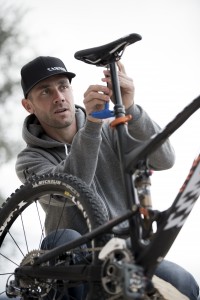Fabien Barel 2004/2005 Downhill World Champion
Fabien Barel is the most analytical man in downhill racing. On the way to winning three world championships, his degree in engineering has helped him push the boundaries of geometry and bike set-up.
From riding techniques to equipment performance, he has left no stone unturned in his quest for speed.
Single finger salute
Most brakes today have the performance needed to brake with one finger. Set your levers to get your first finger on the end for the maximum of leverage.
Don’t be a drag
If you drive a mountain pass in a car and leave your foot on the brake all the way down, you will end up with a brake failure. It’s the same thing on a bicycle. You need to brake at the right point, but you need to let go at some other, or you will overheat the hydraulics.
One step back, two steps forward
To apply any new technique you need to slow down. To be able to go faster you need to learn a new technique by being a lot slower. Why do you need to do that? First of all you need to analyse it, second of all feel it and third do it.
The three stages
We are a gravity sport not an engine sport. We don’t have the power to get ourselves out of corners, so we need to be able to carry speed. Say 100% is a full corner.
Your change of direction needs to be done 80% in the first 50%. The last 50% of the corner you will only turn 20% and you will focus on using the terrain or pedalling to accelerate.
Speed comes from flow
Getting the momentum right is how you increase speed. Speed is not so much from one corner or another, it’s the average speed all along the track.
>>> How to flow with Brendan Fairclough
Get a grip
When the rear wheel goes under braking, if you let the brake go the grip comes back. If you are fully relaxed with your ankle down you still have all your leg strength to dig your tyre and get your grip back.
>>> Find the most grippy tyres here
The bike as an extension of your body
- We have a body, we have the terrain, we have a machine in between that will transfer what is on the terrain. For this you need to make sure that this extra part of your body (the bike) is completely dialled to your body geometry to be able to apply the exact pressure you want between the front and the rear wheel. It comes a lot from the reach and stack and the overall wheelbase. Don’t take a bike that is too small; the wheelbase is going to provide you the stability. Your brake lever position is also one of the variables.
- If you have the brake levers too low, you end up having the bar pressure more on the thumb than on the inside of your hand. You want to have your lever slightly higher than the flat part of your arm so that when you stand on the bike and you have your fingers on the lever, you almost do press up on the bar. If you imagine yourself doing a press up with a bar in your hand not on the flat, you will not do it with your hand tight. This is something that really, really helps for all types of arm pump.
- If you are late braking you shift your weight over the back, you hit the rear brake really hard. You basically have no load over the front, so no possibility to transfer your mass or change direction. Learn to set yourself in the centre of the bike, arms slightly bent and have your heels down to apply maximum load to the rear wheel. Control the rear traction with your ankle by making sure that you’re not permanently sliding. You need to also apply pressure on the front as 70% of your braking comes from the front wheel.
- Your best suspension is your arms and legs. You’ve got maximum 200mm of travel coming out of the bike but you have more than a metre coming from your arms and legs. Bike suspension is there for the grip and the wheel traction; it provides you the wheel contact with the terrain. The rest has to be done through your body. If you ride with your legs fully extended or your arms fully extended, it’s like setting your suspension with no sag. You have to have 20% sag in your arms and legs. For that you need to play with your handlebar height and with your stem length.





